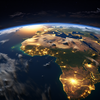Why expensive power could soon accelerate, rather than retard, the US EV adoption divide
Thus far US BEV adoption has largely been strongest in areas that have higher residential power prices. What if that became a feature, not a bug?
Does the region want to be last man standing on ICE, or jump straight to electrification?

The Global South has an opportunity to 'leapfrog' its technology supply chain to BEVs and play an active role in the future automotive market, according to a report from non-profit Carbon Tracker.
By setting stringent vehicle emissions policies for used and new vehicles, countries in the region could incentivise domestic production and sales of BEVs.
"BEV technology has already progressed to a stage where the Global South can remove its dependency on fossil fuels to effectively leapfrog to BEVs, improving accessibility to these vehicles, and reap the financial and economic rewards, as well as lower costs for consumers," says the report, entitled 'Driving Change: How Electric Vehicles can Rise in the Global South'.
Uptake of BEVs in the Global South has so far been sluggish, with new BEV sales generally limited to the very wealthy. Outside the three major EV markets of China, europe and the US, electric car sales are expected to represent only 2-3pc of car sales in 2023, according to the IEA.
But analysis by Carbon Tracker found that the economies of 12 countries — Algeria, Argentina, Brazil, Egypt, India, Indonesia, Kenya, Nigeria, Mexico, Morocco, South Africa and Uganda — could collectively save over $100bn on refuelling costs annually by switching from an ICE fleet to a BEV fleet.
In most Global South countries fuel demand cannot be met with domestic refining of oil — meaning transport fuels must be imported. This leaves such countries exposed to prices dictated by market factors outside of their control, the report notes.
But many of the countries have excellent renewable resources and therefore the potential for very low wholesale electricity costs. The leapfrog to BEVs would therefore have to happen in tandem with a domestic deployment of renewable power.
Any such leapfrog could also help incentivise a development of the BEV value chain — currently concentrated in the Northern hemisphere countries — including in the materials processing, manufacturing, infrastructure and critical mineral recycling sectors.
ICE dumping gorund
Price sensitivity in the Global South has meant that the region has become predominantly an export destination of older used vehicles from five main markets in the northern hemisphere – Europe, US, Japan, South Korea, and China.
This raises the risk that, as their traditional markets phase out ICE vehicle sales, OEMs may look to countries in the Global South, often with less stringent emissions policies, to prop up sales.
According to the Sustainable Africa Scenario in the IEA's Africa Energy Outlook 2022, sub-Saharan Africa becomes the world’s largest importer of transport fuels by 2030, in part due to these legacy ICE vehicles finding new homes there.
But if countries in this region introduce emissions standards and ICE vehicle phase-out targets such as those in the northern hemisphere, BEV manufacturers could begin starting to target these markets as well.
"The ability of OEMs, for example BYD, to export BEVs in large numbers in the next few years or engage in Foreign Direct Investment (FDI) in the Global South is therefore increasing rapidly as an option as their domestic sales growth reaches a maximum. Exports and international production in less competitive markets will attract capital," says the report.
Some progress is being made. In India, EV and component manufacturing is ramping up, supported by the government’s $3.2bn incentive programme. Electric car sales in the nation in the first quarter of 2023 doubled on the same period in 2022.
Thailand and Indonesia are also strengthening their policy support schemes. And Japan's Toyota has already acknowledged that a domestic surplus of BEV production in China is spilling over exports that are speeding the growth of BEV penetration into other national markets in southeast Asia.
Insider Focus LTD (Company #14789403)